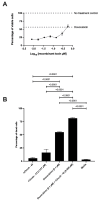Ion-Channel-Targeting Scorpion Recombinant Toxin as Novel Therapeutic Agent for Breast Cancer
- PMID: 40278664
- PMCID: PMC12030950
- DOI: 10.3390/toxins17040166
Ion-Channel-Targeting Scorpion Recombinant Toxin as Novel Therapeutic Agent for Breast Cancer
Abstract
Breast cancer remains the leading cause of cancer-related mortality among women worldwide, with limited therapeutic efficacy due to treatment resistance and adverse effects. Emerging evidence suggests that ion channels play crucial roles in tumor progression, regulating proliferation, apoptosis, migration, and metastasis. Voltage-gated potassium (Kv) and sodium (Nav) channels have been implicated in oncogenic signaling pathways. Scorpion venom peptides, known for their selective ion-channel-blocking properties, have demonstrated promising antineoplastic activity. This study explores the potential therapeutic applications of bioactive fractions derived from Chihuahuanus coahuilae, in breast cancer cell lines. Through chromatographic separation, mass spectrometry, and functional assays, we assess their effects on cell viability, proliferation, and ion channel modulation. Our preliminary data suggest that these venom-derived peptides interfere with cancer cell homeostasis by altering ion fluxes, promoting apoptosis, and inhibiting metastatic traits. These findings support the therapeutic potential of ion-channel-targeting peptides as selective anticancer agents. Further investigations into their molecular mechanisms may pave the way for novel, targeted therapies with improved efficacy and specificity for breast cancer treatment.
Keywords: C. coahuliae; antineoplastic; breast cancer; cell viability; doxorubicin; ion channel; proliferation.
Conflict of interest statement
The authors declare no conflicts of interest.
Figures




Similar articles
-
Short Peptides from Asian Scorpions: Bioactive Molecules with Promising Therapeutic Potential.Toxins (Basel). 2025 Feb 28;17(3):114. doi: 10.3390/toxins17030114. Toxins (Basel). 2025. PMID: 40137887 Free PMC article. Review.
-
Pleiotropic Anticancer Properties of Scorpion Venom Peptides: Rhopalurus princeps Venom as an Anticancer Agent.Drug Des Devel Ther. 2020 Feb 27;14:881-893. doi: 10.2147/DDDT.S231008. eCollection 2020. Drug Des Devel Ther. 2020. PMID: 32161447 Free PMC article. Review.
-
Functional role of Kv1.1 and Kv1.3 channels in the neoplastic progression steps of three cancer cell lines, elucidated by scorpion peptides.Int J Biol Macromol. 2018 May;111:1146-1155. doi: 10.1016/j.ijbiomac.2018.01.144. Epub 2018 Feb 19. Int J Biol Macromol. 2018. PMID: 29415410
-
Anticancer potentiality of Hottentotta saulcyi scorpion curd venom against breast cancer: an in vitro and in vivo study.Sci Rep. 2024 Oct 19;14(1):24607. doi: 10.1038/s41598-024-75183-w. Sci Rep. 2024. PMID: 39427017 Free PMC article.
-
Scorpion Venom Causes Upregulation of p53 and Downregulation of Bcl-xL and BID Protein Expression by Modulating Signaling Proteins Erk1/2 and STAT3, and DNA Damage in Breast and Colorectal Cancer Cell Lines.Integr Cancer Ther. 2018 Jun;17(2):271-281. doi: 10.1177/1534735417704949. Epub 2017 Apr 25. Integr Cancer Ther. 2018. PMID: 28438053 Free PMC article.
References
-
- OMS Cáncer. [(accessed on 14 September 2023)]. Available online: https://www.who.int/es/news-room/fact-sheets/detail/cancer.
MeSH terms
Substances
Grants and funding
LinkOut - more resources
Full Text Sources
Medical

